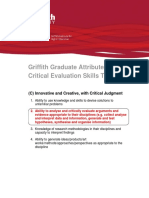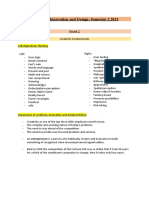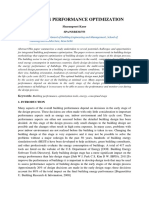Research Poster
Research Poster
Uploaded by
Victor AceroCopyright:
Available Formats
Research Poster
Research Poster
Uploaded by
Victor AceroOriginal Description:
Copyright
Available Formats
Share this document
Did you find this document useful?
Is this content inappropriate?
Copyright:
Available Formats
Research Poster
Research Poster
Uploaded by
Victor AceroCopyright:
Available Formats
Enhancement of High-Performance Graphene Biosensors for
Cancer Detection
VictorAcero ,ShotaSando ,TianhongCui 1 2 2
DepartmentofMechanicalandNuclearEngineeringThePennsylvaniaStateUniversity 1
DepartmentofMechanicalEngineeringUniversityofMinnesotaTwinCities 2
Backgrounds Goals
Elevated alpha-fetoprotein (AFP) levels are tied to issues with the Develop graphene biosensor capable of detecting low levels of alpha-
liver cancer and ovarian cancer1. Enhanced detection of AFP would fetoprotein. We will use graphene because it is a 2D material, and
allow for quicker medical responses. therefore hyper-sensitive to its environment
Current tests such as ELISA are complicated, slow, and require fine Detect AFP concentrations in a matter of minutes
tuning for antigen being detected Lower 1/f noise levels via graphene-gold interface redesign
FabricationProcess
Start Pattern Gold onto Wafer Pattern Graphene onto sensing area Pattern KMPR window onto sensor
Photolithography is used to: Testing With and Without KMPR Fully fabricated
Pattern to basic gold electrode shape Graphene Bio-Sensor
Current
Pattern graphene onto sensing area Current 70% Success
Pattern protective KMPR coating
10 mm width
13 mm height
.55 mm depth
GrapheneLayerbyLayerSelfAssembly pHTesting
Graphene LbL Self-Assembly uses negative/positive polyelectrolyte and Graphene changes resistance
graphene solutions to form few-layer graphene depending on surroundings
Holes are main charge carriers in
PSS PDDA graphene.
2 Nearby negative charges decrease
cycles Resistance
Nearby Positive charges increase
resistance
Graphene
Graphen Polyelectrolytes
PDDA
e 5 Tunable graphene thickness
cycles Tunable optical, mechanical, and electrical properties
Graphene self assembly is possible on various substrates Graph 1 As pH is increased the resistance
Large surface area graphene increases. Sensitivity in the reverse in poor
Mass production is realistic unlike with traditional methods because of H+ contamination on surface.
AFPDetectionTest Functionalization Conclusions
1. Coat Graphene with Poly-L-lysine AFP Sensing: Our data showed
Graph 2: AFP concentrations Helps Anti-AFP bind to Graphene
the sensors that were fabricated
1 pg/ml
were slowly increased by one
5200
order of magnitude at a time.
2. Functionalize surface with Anti-AFP
had at least the same sensitivity as
10 pg/ml
Large spikes in graph are due 3. Fill gaps with Bovine Albumin Serum
100 pg/ml
5000
to pressure changes when Keeps unbound AFP and Ions from lodging between Anti-AFP ELISA under ideal conditions. Our
Resistance (Ohms)
1 ng/ml
10 ng/ml
changing solutions. 4. Introduce solution with AFP
4800 100 ng/ml
Increase concentration slowly sensors also responded in a matter
(Inset) : Normalized AFP of seconds to elevated AFP
4600
Sensing data demonstrates
concentrations, as opposed to
-0.03
-0.04
the relationship between
Normalized Resistance Shift
-0.05
AlphaFetoprotein
within hours, as with ELISA.
-0.06
-0.07
4400 -0.08
-0.09
resistance and AFP
concentration
-0.10
-0.11
-0.12
4200 1E-13 1E-12 1E-11 1E-10 1E-9 1E-8 1E-7 1E-6
AFP Concentration (g/ml)
BovineSerumAlbumin Noise Reduction: Reduction in
AntiAlpha
0 500 1000
Time (s)
1500 2000 2500 3000
Fetoprotein
GrapheneandPolyLlysine the overall surface area contact
between the gold-graphene
GoldGrapheneInterfaceRedesign NoiseReductionData interface showed a reduction in 1/f
Graph 3: Dynamic 1/f Noise No
NoStrip
Strip 31 Strips: 1/3 Original Surface Area
noise levels.
0.0055 31 Strip
31 Strip
signal analyzer was
0.0055
No Strip 95Strip
95 Strip
20 um strip width / 40 um gap
Acknowledgements
0.00500.0055
0.0050 31 Strip 950 Strip
950 Strip
used to determine the 95 Strip
Power Spedctrum Density (V^2/Hz)
95 Strips: Original Surface Area
0.0045
0.0050
Power Spedctrum Density (V^2/Hz)
0.0045 950 Strip
0.0040
PSD and find 1/f noise.
Power Spedctrum Density (V^2/Hz)
0.0045 1
0.00400.0040 0.0035
0.1
20 um strip width / 20 um gap NNIN/NSF
Power Spectrum Density (V^2/Hz)
0.01
However a DC voltage 0.00350.0035 0.0030
1E-3
1E-4
1E-5 950 Strips: Original Surface Funding and academic support throughout the
0.0025
source is used when 0.0030
0.0030
0.0025
0.0020
1E-6
1E-7
Area project
detecting AFP, so the
1E-8
0.0025 0.0015
2 um strip width / 2 um gap National Science Foundation - Grant No. ECCS-
1E-9
0.0020
1E-10
0.00200.0015 0.0010
higher frequency noise
1E-11
0.0015
0.0010
0.0005
1E-12
1E-13 0335765
spectrum (White Noise)
1E-14
0.0000
0.0010
0.0005
0.0000
-0.0005
1 10 100
Frequency (Hz)
1000
UMN MRSEC
is not relevant to finding 0.0005-0.0005
0 2 4
Frequency (Hz)
6 8 10
Academic advising and professional
1/f noise for the sensor.
0 2 4 6 8 10
0.0000 Frequency (Hz) development
-0.0005
0 2 4 6 8 10
TIAN Lab
Resources and additional financial support
Frequency (Hz)
1/fdominatessignaltonoiseratioinnanoelectronicsand
Tianhong Cui/Shota Sando
(Inset) : The resolution at low frequencies is poor due to not having a greatlyaffectssensitivity.Sensorswereredesignedtohave Principle Investigator and Graduate Student
low-frequency amplifier, however it is still capable of demonstrating that reducedsurfaceareacontact Mentor respectively, who provided guidance
the reduction in surface area was capable of reducing overall 1/f noise Contactresistancecontributegreatlyto1/f throughout the summer. They advised me on
in the sensor. Reductioninoverallsurfaceareareducedoverallnoise research and aided in professional development
You might also like
- 2) Fusion Intercompany Setup - DocumentDocument13 pages2) Fusion Intercompany Setup - Documentkeerthi_fcma100% (2)
- Capital Struture Analysis Oman CompaniesDocument9 pagesCapital Struture Analysis Oman CompaniesSalman SajidNo ratings yet
- Document Heading: Subtitle, Date or Author Second LineDocument4 pagesDocument Heading: Subtitle, Date or Author Second LineSiti Zsa Zsa ZakiahNo ratings yet
- Test Bank For Managerial Accounting 4th Canadian Edition by WeygandtDocument35 pagesTest Bank For Managerial Accounting 4th Canadian Edition by WeygandtsarahNo ratings yet
- Big Data Analysis ReportDocument30 pagesBig Data Analysis ReportExample ExNo ratings yet
- Critical Evaluation Skills PDFDocument42 pagesCritical Evaluation Skills PDFSharmaine Dalisay SabinianoNo ratings yet
- Assignment QuestionsDocument5 pagesAssignment QuestionsRAJAT BANSAL0% (1)
- Creativity and InnovationDocument4 pagesCreativity and InnovationAlexNo ratings yet
- Creativity, Innovation and Design NotesDocument20 pagesCreativity, Innovation and Design NotesGeegNo ratings yet
- EVAL FormDocument2 pagesEVAL Formcindy_argueta_5No ratings yet
- Genigraphics Poster Template 36x36Document1 pageGenigraphics Poster Template 36x36Iqbal Hossain NoyonNo ratings yet
- Competencies and CapabilitiesDocument10 pagesCompetencies and CapabilitiesMarwan BecharaNo ratings yet
- Strategic Development Assignment 2Document12 pagesStrategic Development Assignment 2rowlandNo ratings yet
- Cep Micro2 170857Document13 pagesCep Micro2 170857Ramsha MalikNo ratings yet
- Globalisation and ManagementDocument6 pagesGlobalisation and ManagementmickyNo ratings yet
- Ch04ppsolutions PDFDocument3 pagesCh04ppsolutions PDFJojo SullivanNo ratings yet
- Answer:: Wilson Wonders's Bonds Have 12 Years Remaining To Maturity. Interest Is Paid Annually, TheDocument2 pagesAnswer:: Wilson Wonders's Bonds Have 12 Years Remaining To Maturity. Interest Is Paid Annually, TheIbra TutorNo ratings yet
- Implementing A Histogram Equalization AlgorithmDocument11 pagesImplementing A Histogram Equalization AlgorithmmuucoolNo ratings yet
- Operations ManagementDocument178 pagesOperations ManagementRocky RazzNo ratings yet
- Poster For PresentationDocument37 pagesPoster For PresentationMulia FNo ratings yet
- Wong and Brown-The Water Sensitive City - Principles For PracticeDocument10 pagesWong and Brown-The Water Sensitive City - Principles For PracticeIgnacio CancinoNo ratings yet
- Edc-Open Ended Lab: BEE - 56 A Capt Adnan Ahmad KhanDocument5 pagesEdc-Open Ended Lab: BEE - 56 A Capt Adnan Ahmad Khanadnan3ahmad3khan-2No ratings yet
- Lecturenote - 1938410780chapter 9 - Emerging Trends in Software Engineering (Lecture 15)Document20 pagesLecturenote - 1938410780chapter 9 - Emerging Trends in Software Engineering (Lecture 15)Miretu JaletaNo ratings yet
- Handout 03 Continuous Random VariablesDocument18 pagesHandout 03 Continuous Random Variablesmuhammad ali100% (1)
- PMLect 3Document4 pagesPMLect 3api-3697776No ratings yet
- Econometrics For FinanceDocument54 pagesEconometrics For Financenegussie birie100% (1)
- Strategic Drift: Phase 1 - Incremental ChangeDocument1 pageStrategic Drift: Phase 1 - Incremental ChangeHarsh Anchalia100% (1)
- Tacheometric SurveyingDocument19 pagesTacheometric SurveyingAbu ZaforNo ratings yet
- Describe Four You Would Implement When Managing A Team To Ensure That All Members Are Clear On Their Responsibilities and RequirementsDocument12 pagesDescribe Four You Would Implement When Managing A Team To Ensure That All Members Are Clear On Their Responsibilities and RequirementssumanpremNo ratings yet
- tmpAF8A TMPDocument7 pagestmpAF8A TMPFrontiersNo ratings yet
- Contingency Approaches To Ma NagementDocument31 pagesContingency Approaches To Ma NagementmavimalikNo ratings yet
- IES Electronics and CommunicationDocument11 pagesIES Electronics and Communicationsuraj0% (1)
- Introduction To Factor Analysis (Compatibility Mode) PDFDocument20 pagesIntroduction To Factor Analysis (Compatibility Mode) PDFchaitukmrNo ratings yet
- MBA Semester II Assignment 2 - : MB0048 - Operations Research - 4 Credits MB0048Document12 pagesMBA Semester II Assignment 2 - : MB0048 - Operations Research - 4 Credits MB0048Anshul MittalNo ratings yet
- Numerical ApertureDocument8 pagesNumerical ApertureAryabrat MahapatraNo ratings yet
- Initial PHD ProposalDocument2 pagesInitial PHD ProposalHafEz100% (1)
- Android Based Health Care Management System 2Document43 pagesAndroid Based Health Care Management System 2Daryll TorresNo ratings yet
- SPSS For Windows: Introduction ToDocument26 pagesSPSS For Windows: Introduction ToganeshantreNo ratings yet
- Nav (New Summative Assessment)Document43 pagesNav (New Summative Assessment)kahlonnavjot74No ratings yet
- The Integration of TQM and BPRDocument18 pagesThe Integration of TQM and BPRdawit melkamuNo ratings yet
- Ch1 v3Document11 pagesCh1 v3Mazin AlahmadiNo ratings yet
- Lesson14PlusGraphs Game TheoryDocument27 pagesLesson14PlusGraphs Game Theoryamrith vardhanNo ratings yet
- JAVA - Optimal Dynamic Path Restoration Mesh NetworkDocument63 pagesJAVA - Optimal Dynamic Path Restoration Mesh NetworkAmir AmirthalingamNo ratings yet
- AICTE Training and Learning (ATAL) Academy: ATAL's Faculty Development Programmes 2022-23Document19 pagesAICTE Training and Learning (ATAL) Academy: ATAL's Faculty Development Programmes 2022-23Kaushik RanaNo ratings yet
- Building Performance Optimization PDFDocument7 pagesBuilding Performance Optimization PDFAR Sharanpreet KaurNo ratings yet
- A RESEARCH PROPOSAL On Design of A Metamaterial Based Absorber For Various PurposesDocument5 pagesA RESEARCH PROPOSAL On Design of A Metamaterial Based Absorber For Various PurposesKabir Nipun0% (1)
- Unit 10 Randomised Block Design: StructureDocument16 pagesUnit 10 Randomised Block Design: Structurejv YashwanthNo ratings yet
- NPV Graph and SpreadsheetsDocument3 pagesNPV Graph and SpreadsheetsSrinivas Meduri100% (1)
- Feasibility StudyDocument17 pagesFeasibility StudyKen ReyesNo ratings yet
- Technical Seminar Report FormatDocument6 pagesTechnical Seminar Report FormatLalit TananNo ratings yet
- Chapter 06 Concept GenerationDocument18 pagesChapter 06 Concept GenerationTetra Ethayle RahatNo ratings yet
- Midterm - Draft - (November - 2022) - Continum - V9Document13 pagesMidterm - Draft - (November - 2022) - Continum - V9Badro Badreddine MimouniNo ratings yet
- Nagurney Humanitarian Logistics Lecture 5Document74 pagesNagurney Humanitarian Logistics Lecture 5Abhishek PuriNo ratings yet
- Smoothing MethodsDocument52 pagesSmoothing MethodsEko Budiatmodjo100% (1)
- Meaning and Definition of Operation ResearchDocument4 pagesMeaning and Definition of Operation ResearchAdugna GirmaNo ratings yet
- Complex Engineering Problem Presentation 10-06-2021Document16 pagesComplex Engineering Problem Presentation 10-06-2021Ahmad Shah 8999No ratings yet
- Concept Selection (Innovation)Document20 pagesConcept Selection (Innovation)Salih A. Razag Jr.No ratings yet
- Dr. T. K. Kundu: Lecture 1: Introduction and Potential ModelDocument35 pagesDr. T. K. Kundu: Lecture 1: Introduction and Potential ModelPradeep SijeriyaNo ratings yet
- FYP ReportDocument42 pagesFYP ReportImtiaz Aziz100% (2)
- Environmental Engineering SyllabusDocument27 pagesEnvironmental Engineering SyllabusSuganya PeriasamyNo ratings yet
- Ultrasonic Technology Seals The DealDocument10 pagesUltrasonic Technology Seals The DealНиколайNo ratings yet
- Theme: Oil & Gas Transportation and Storage Sub-Theme: Multiphase Flow & ModelingDocument17 pagesTheme: Oil & Gas Transportation and Storage Sub-Theme: Multiphase Flow & ModelingJosh SabimanNo ratings yet
- A Holistic Workflow For Evaluating and Developing SRR - CypherDocument23 pagesA Holistic Workflow For Evaluating and Developing SRR - CypherQingming MaNo ratings yet
- Baylor College of Medicine Cover LetterDocument4 pagesBaylor College of Medicine Cover LetterVictor AceroNo ratings yet
- Victor Acero, Liting Duan, Jen Hope, Bianxiao Cui The Pennsylvania State University, Stanford UniversityDocument1 pageVictor Acero, Liting Duan, Jen Hope, Bianxiao Cui The Pennsylvania State University, Stanford UniversityVictor AceroNo ratings yet
- Stanford (Biophysics) Personal StatementDocument2 pagesStanford (Biophysics) Personal StatementVictor Acero100% (4)
- Foodarom Cover LetterDocument4 pagesFoodarom Cover LetterVictor AceroNo ratings yet
- NNIN Report FinalDocument4 pagesNNIN Report FinalVictor AceroNo ratings yet
- Johns Hopkins (Chemical Engineering) Personal StatementDocument3 pagesJohns Hopkins (Chemical Engineering) Personal StatementVictor AceroNo ratings yet
- Modulation of Light-Induced Homo-Oligomerization of Cryptochrome2Document25 pagesModulation of Light-Induced Homo-Oligomerization of Cryptochrome2Victor AceroNo ratings yet
- University of Pennsylvania (Materials Science) Personal StatementDocument2 pagesUniversity of Pennsylvania (Materials Science) Personal StatementVictor AceroNo ratings yet
- HEARSAY ZimbabweDocument13 pagesHEARSAY Zimbabwejagiellonianuniversity.p.e.uNo ratings yet
- MX43Document7 pagesMX43Cost RootsNo ratings yet
- Solar Panel Project Proposal by SlidesgoDocument47 pagesSolar Panel Project Proposal by SlidesgoDAVID ANTONIO BARROS VALLENo ratings yet
- Dod Acronym ListDocument12 pagesDod Acronym ListboluduNo ratings yet
- Accounting Academic Leveling CourseDocument97 pagesAccounting Academic Leveling Coursedavejal17No ratings yet
- WK 11 Pitching (Document9 pagesWK 11 Pitching (Kamarul Aizat Abdul KhalidNo ratings yet
- PolimerDocument31 pagesPolimerAlief MoulanaNo ratings yet
- Install OLIMEXINO-328: 1.installation of The Arduino-Based BoardDocument15 pagesInstall OLIMEXINO-328: 1.installation of The Arduino-Based BoarddataromaNo ratings yet
- Namma Kalvi 12th Economics Full Study Material em 220304Document116 pagesNamma Kalvi 12th Economics Full Study Material em 220304Asha HariNo ratings yet
- Radio Button Group by IndexDocument18 pagesRadio Button Group by IndexHemanth Kumar PanagamNo ratings yet
- Huchapter 41 Statement of Cash Flows: Problem 41-1: True or FalseDocument14 pagesHuchapter 41 Statement of Cash Flows: Problem 41-1: True or FalseklairvaughnNo ratings yet
- Chillicothe Police ReportsDocument79 pagesChillicothe Police ReportsAndrew AB BurgoonNo ratings yet
- Squeezing Loading of Segmental Lining and The Effect of BackfillingDocument26 pagesSqueezing Loading of Segmental Lining and The Effect of BackfillingCarmine TranfaNo ratings yet
- 02-Active Directory Domain ServicesDocument30 pages02-Active Directory Domain ServicesDavitNo ratings yet
- Well Completion Design 1: Breakout SessionDocument8 pagesWell Completion Design 1: Breakout SessionKhalid ZaeemNo ratings yet
- What Is The Risk Management Process?Document36 pagesWhat Is The Risk Management Process?el khaiat mohamed amineNo ratings yet
- Complete Products ListDocument20 pagesComplete Products ListHina Tina100% (1)
- Water ManagementDocument13 pagesWater Managementshinexixi100% (1)
- Danfoss Optimum Control HexDocument10 pagesDanfoss Optimum Control HexFelipe GuerraNo ratings yet
- Ashtakavarga System of Prediction: Once We Get A Horoscope For AnalysisDocument5 pagesAshtakavarga System of Prediction: Once We Get A Horoscope For AnalysisВадим Батыров0% (1)
- Digital Transformation - Online Guide To Digital TransformationDocument36 pagesDigital Transformation - Online Guide To Digital TransformationAimi SuhailaNo ratings yet
- MN - 2019 07 09Document28 pagesMN - 2019 07 09mooraboolNo ratings yet
- Delhi Public School (P) LTD.: Schools in IndiaDocument8 pagesDelhi Public School (P) LTD.: Schools in IndiaKamaljeet SinghNo ratings yet
- Sharma/Kamlesh MS: Boarding PassDocument2 pagesSharma/Kamlesh MS: Boarding PassAshutosh kaushikNo ratings yet
- Arkansas Current - Grain - Warehouse - ListDocument2 pagesArkansas Current - Grain - Warehouse - Listtroub X2No ratings yet
- TDS Weberanc 405 BFXDocument14 pagesTDS Weberanc 405 BFXTawfeek JadidNo ratings yet
- DEORE Rear Derailleur: (10-Speed)Document1 pageDEORE Rear Derailleur: (10-Speed)Marcos ZanelliNo ratings yet

































































































